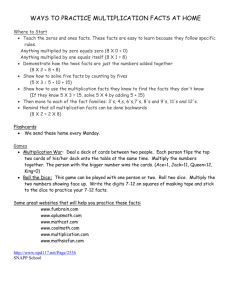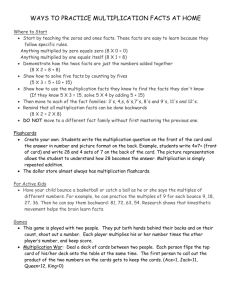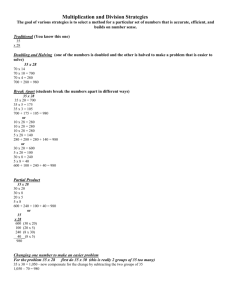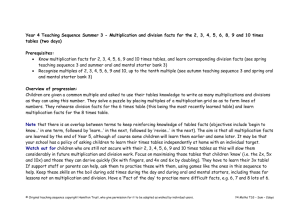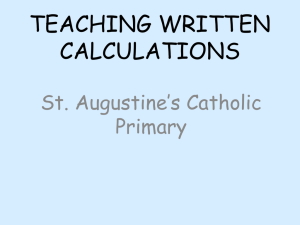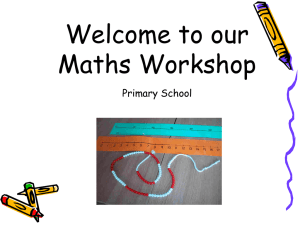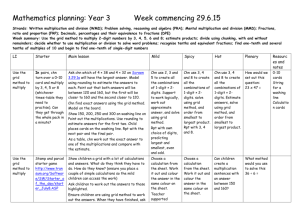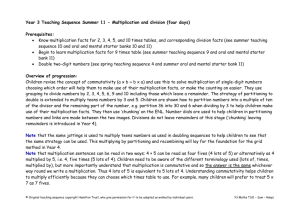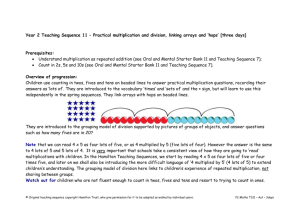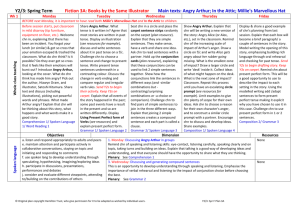Summer TS 10 - Hamilton Trust
advertisement
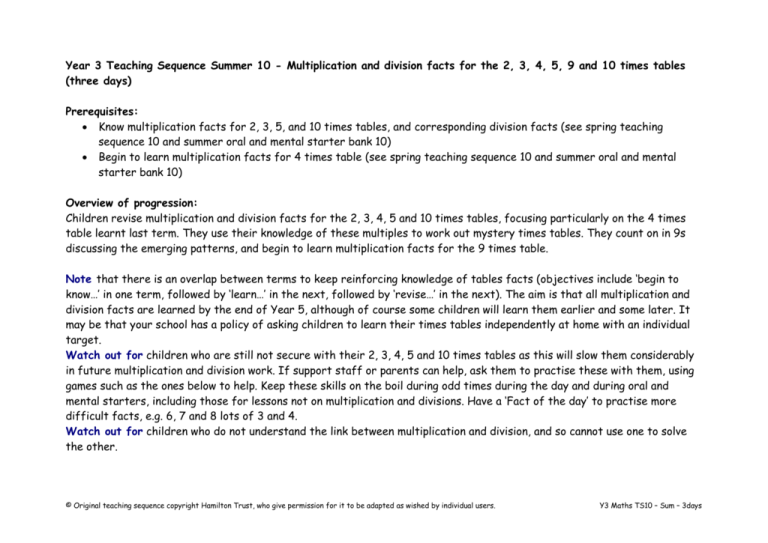
Year 3 Teaching Sequence Summer 10 - Multiplication and division facts for the 2, 3, 4, 5, 9 and 10 times tables (three days) Prerequisites: Know multiplication facts for 2, 3, 5, and 10 times tables, and corresponding division facts (see spring teaching sequence 10 and summer oral and mental starter bank 10) Begin to learn multiplication facts for 4 times table (see spring teaching sequence 10 and summer oral and mental starter bank 10) Overview of progression: Children revise multiplication and division facts for the 2, 3, 4, 5 and 10 times tables, focusing particularly on the 4 times table learnt last term. They use their knowledge of these multiples to work out mystery times tables. They count on in 9s discussing the emerging patterns, and begin to learn multiplication facts for the 9 times table. Note that there is an overlap between terms to keep reinforcing knowledge of tables facts (objectives include ‘begin to know…’ in one term, followed by ‘learn…’ in the next, followed by ‘revise…’ in the next). The aim is that all multiplication and division facts are learned by the end of Year 5, although of course some children will learn them earlier and some later. It may be that your school has a policy of asking children to learn their times tables independently at home with an individual target. Watch out for children who are still not secure with their 2, 3, 4, 5 and 10 times tables as this will slow them considerably in future multiplication and division work. If support staff or parents can help, ask them to practise these with them, using games such as the ones below to help. Keep these skills on the boil during odd times during the day and during oral and mental starters, including those for lessons not on multiplication and divisions. Have a ‘Fact of the day’ to practise more difficult facts, e.g. 6, 7 and 8 lots of 3 and 4. Watch out for children who do not understand the link between multiplication and division, and so cannot use one to solve the other. © Original teaching sequence copyright Hamilton Trust, who give permission for it to be adapted as wished by individual users. Y3 Maths TS10 – Sum – 3days Objectives: Count on in 9s, look at patterns, investigate general statements Revise multiplication facts for 2, 3, 4, 5 and 10 times tables, and learn corresponding division facts Begin to learn multiplication facts for 9 times table Whole class Group activities Paired/indiv practice Resources Launch the Number Dials ITP, ask chn to close their eyes whilst you click the pair of dice (this randomises the central number and the order of the multipliers round the edge of the circle), click to reveal the central number and change it to 3, then click to hide it again. Open your eyes; I want you to guess what times table I have chosen. Click to reveal some of the outside numbers. What times table could it be? Could it be the twos? Why not? Group of 4-5 children Each pair take it in turns to spin a paper clip round a pencil on a spinner labelled 2, 3, 5 and 10 (see resources) and then find a number on a grid (see resources) that the number spun will go into. So for example if they got 5 they ring a number on the grid that 5 will go into. They write the division on their whiteboard. If this is correct, they put a cube of their chosen colour on the number on the grid. Each pair use a different colour. They try three numbers in a row, horizontally, vertically or diagonally. Easier: Make a list of multiples of 3 on the flipchart to help. Chn play in pairs, one choosing the three times table and the other the five times table. They start at the left or top of a grid (see resources), choose a hexagon, and have to say a division fact beginning with the number, e.g. for 24 say 24 divided by 3 is 8. If their partner agrees they place a counter on the hexagon. The aim is to be the first one across to the opposite side of the grid. Easier: Chn say a multiplication fact with the number on the grid as the answer. ITP Number dials Multiples grid, spinner (see resources) and cubes Hexagon grid (see resources) and counters Reveal more products until it is obvious, click to reveal the central number. Repeat this time with the 2, 4, 5 and 10 times tables. © Original teaching sequence copyright Hamilton Trust, who give permission for it to be adapted as wished by individual users. Y3 Maths TS10 – Sum – 3days Use the counting stick quickly to support counting on in fours. Stop occasionally and ask division questions, e.g. How many fours are in 24? What division can we write? Point to random points along the counting stick, asking chn for the corresponding multiple. Repeat counting in 2s and then 5s. You may wish to use Post-its™ to label 20 and 40 to begin with. Group of 4-5 children Ask chn to sketch a 3 by 2 grid on their boards and choose six multiples of 4 to write on it. What are five 4s? If you have the answer, ring it on your board. Ask other multiplication facts until one child has ringed all six numbers on his/her board. If chn don’t know the answer, encourage them to count on in fours using fingers to find it. Repeat, but this time chn choose six numbers from 1 to 10 to write on their grids. Ask division question such as: How many 4s in 12? Easier: Write a list of multiples of 4 on the flipchart to help. Give each pair a 1-10 dice. Chn roll the dice and draw that numbers of hops of 4 on an ENL and write the corresponding divisions, e.g. 36 ÷ 4 = 9. When they have all the possible divisions, they sketch a 3 by 2 grid on their boards and choose six multiples of 4 to write on it. Working in pairs, they roll the dice, work out that number of 4s, and ring the answer if they have it. The first one to ring all six numbers wins. Easier: Chn record hops of 4 on a 0-40 beaded line and record both the multiplication and division facts. They use the multiplication facts to help them to play the dice game. 1-10 dice 0-40 beaded lines (see resources) Count on in nines along the counting stick, slowly at first. What’s a quick way to add on 9? Write the multiples of nine on Post-its™ and stick them onto the counting stick. Repeat, this time saying the multiplication facts, one 9 is nine, two 9s are 18, three 9s are 27… Repeat occasionally stopping to ask: So how many 9s are in 27? How many 9s are in 45? Repeat, but first removing 18, 54 and 81. Repeat, removing 27, 36 and 72. Ask chn to hold up their hands facing towards Group of 4-5 children Together write the multiples of 9 on the board as you put down the first, then second, then third finger and so on to show the multiple of nine as in the whole class teaching. Ask chn to sketch a 3 by 2 grid on their boards and choose six of these numbers to write on it. What are three 9s? If you have the answer, ring it on your board. Ask other multiplication facts until one Give each pair a 1-10 dice. Chn roll the dice and draw that number of hops of 9 on a 0-100 beaded line and write the corresponding multiplications. When they have all the possible multiplications, they turn over their work, sketch a 3 by 2 grid on the other side and choose six multiples of 9 to write on it. Working in pairs, they roll the Counting stick and Post-its™ ITP Number grid 1-10 dice 0-100 beaded lines (see resources) © Original teaching sequence copyright Hamilton Trust, who give permission for it to be adapted as wished by individual users. Y3 Maths TS10 – Sum – 3days them, and count from left to right. Put down your second finger. What are two 9s? What do you notice about your fingers? Point that they have one ‘finger’ (actually thumb) standing up before the folded down finger, and eight afterwards, 1 and 8 making the two digits of 18. Now fold down your third finger. This is the answer to three 9s, can you see it? Repeat using fingers to show four 9s, five 9s… ten 9s, nine tens and no ones after the last folded down finger (thumb in this case). Now ask 9x table questions out of order, asking chn to use their fingers to help them. Launch the ITP Number grid, and use the toggle to highlight multiples of 9. What do you notice? Why do you think the 9s have this pattern? What happens when you add nine to numbers on this grid? What else do you notice about the multiples of nine? Draw out that the digits add to 9. This is a very special table! What about 99 though? Discuss that the digits add to 18, but then the digits in 18 add to 9, and so 99 is still a multiple of 9. Work with a partner to make up a really big multiple of nine and write it on your whiteboards. child has ringed all six numbers on his/her board. If chn don’t know the answer, encourage them to use their fingers to help. Repeat. Easier: Give chn 0-100 beaded lines, ask them to mark on hops of 9 labelling where they land and use this to help them to answer the questions. Harder: After the first game, cover up the multiples of 9 on the flipchart. dice, work out that number of 9s, check the answer on the back and ring the answer if they have it and they were correct. The first one to ring all six numbers wins. Harder: Chn draw their own empty number lines. © Original teaching sequence copyright Hamilton Trust, who give permission for it to be adapted as wished by individual users. Y3 Maths TS10 – Sum – 3days

